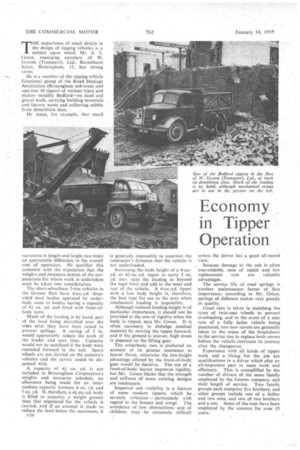Economy.
Page 60

If you've noticed an error in this article please click here to report it so we can fix it.
in Tipper Operation
T
HE importance of small details in the design of tipping vehicles is a ' subject upon which Mr. S. T. Green, managing secretary of W. Groom (Transport), Ltd., Ravenhurst Street. Birmingham, 12, has strong views.
,.. He is a member of the tipping vehicle functional group of the Road Haulage Association (Birmingham sub-area) and operates 16 tippers of various types and makes—notably Bedford—on sand and gravel work, carrying building materials and factory waste and collecting rubble from demolition sites.
He states, for example, that small variations in length and height can make an appreciable difference in the overall cost of operation. He qualifies this comment with the stipulation that the weights and measures system of the corporations for whom work is undertaken must be taken into consideration.
The short-wheelbase 5-ton vehicles in the Groom fleet have 4-cu.-yd. dropsided steel bodies operated by underbody rams or bodies having a capacity of 41 Cuyd. and fitted with front-ofbody rams.
Much of the loading is by hand, part of the load being shovelled over the Sides after they have been raised to prevent spillage. A saving of 2 in. would appreciably reduce the work of the loader and save time. Capacity would not be sacrificed if the body were extended forward to the cab. Spare wheels arc Dot Carried on the concern's vehicles and the carrier could be dispensed with.
A capacity of 4i Cuyd. is not included in Birmingham Corporation's weights and measures schedule, no allowance being made for an intermediate capacity between 4 cu. yd. and 5 Cuyd. If, therefore, a 41-cu.-yd. body is filled to capacity, a weight greater than that stipulated for the vehicle is carried, and if an attempt is made to reduce the load below the maximum, it n20 is generally impossible to convince the contractor's foreman that the vehicle is not unclerloaded.
Increasing the body height of a 4-cu.yd. or 41-cu.-yd. tipper to carry 5 Cu. yd. may raise the loading to beyond the legal limit and add to the wear and tear of the vehicle. A 4-cu.-yd. tipper with a low body height is, therefore, the best type for use in the area when mechanical loading is impossible.
Although reduced loading height is of particular importance, it should not be provided at the cost of rigidity when the body is tipped, says Mr. Green. It is often necessary to dislodge residual material by moving the tipper forward, and if the ground is uneven, high stress is imposed on the lifting gear.
The underbody ram is preferred on account of its greater resistance to lateral thrust. otherwise the low-height advantage offered by the front-of-body gear would be decisive. The use of a front-of-body layout improves rigidity, but Mr. Green thinks that the strength and stiffness of some existing designs are inadequate.
Impaired cab visibility is a feature of some modern tippers, which he severely criticizes — particularly with regard to the bonnet and wings. The avoidance of low obstructions, and of children, may be extremely difficult unless the driver has a good all-round view.
Because damage to the cab is often unavoidable, ease of repair and low replacement cost arc valuable advantages.
The service life of road springs is another maintenance factor of .first importance; according to Mr. Green, springs of different makes vary greatly in quality.
Great care is taken in matching the tyres of twin-rear wheels to prevent overloading, and in the event of a rear tyre of a fully laden vehicle being punctured, two new covers are generally taken to the scene of the breakdown in the service van to replace both covers before the vehicle continues its journey after the changeover.
Experience with all kinds of tipper work and a liking for the job are qualifications in a driver which play an all-important part in team work and efficiency. This is exemplified by the number of drivers of the same family employed by the Groom company, and their length of service. Two family groups each comprise five brothers, and other groups include one of a father and two sons, and one of two brothers and a son. Some of the men have been employed by the concern for over 15 years.
















































































































